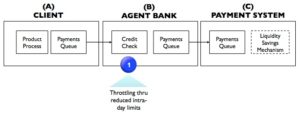 With new rules coming into effect on Jan 1 2015, this is the twelfth in a series of posts on how banks and FI’s might adapt.
With new rules coming into effect on Jan 1 2015, this is the twelfth in a series of posts on how banks and FI’s might adapt.
The Nostros that find that their business is being allocated high liquidity costs have one immediate weapon at their disposal. If they are being allocated costs based on intraday overdrafts given, then they might simply reduce limits. Assuming that some of their clients will be maxing out these lines during the day, this will certainly have an impact on the measurement side.
If this is done, it has an immediate consequence on the payments processing, because the likely result is that more payments are held in a queue waiting for a balance or a limit to be available. This is point 1 in the diagram below. This is like aircraft piling up in a circling pattern over Heathrow Airport; it can be done, but requires careful planning. But what it also does is throttle the flow of payments into the payments systems (C), which in turn has an impact on the ability to meet throughput rules and / or might attract higher costs for the Nostro.
Now, assuming that to date, Nostros have done a good job of optimising across the life cycle of the process, I would maintain that such an action would need to be used very sparingly.
Please Sir, I Want Less
Many will know the famous phrase from the classic film, Oliver: “Please, sir, I want some more!” Indeed, FIs tend to be demanding of their Nostros. Ironically, they might now want to go for the “size zero diet” and ask for less. Normally, an agent bank does not formally disclose either intraday or overnight overdraft limits. This means that they are not committed and have no capital impact. Quite often there is a verbal advice, so both parties know where they stand. This is a perfectly good way to do things, which is very well established.
Now, an FI which has put the measurements into place to meet the BCBS requirements and quite possibly has had an OMG moment could do from its side what we mentioned above, that the Nostro could do from its side. It could go to its Nostro and say, “I know you will not tell me the limit you use, but can I ask you to ensure that my intraday overdraft never exceeds $100 million equivalent, please?”
Ideally, the FI will do that, based on seeing real figures. So if it has measured and sees that in, say, EUR, the balance sometimes gets to, say, 200 million overdrawn, then it would want to pitch the level below that.
Lessons Learned: The conversation ought to have a satisfactory outcome—in isolation. In isolation, because if all clients did this and all clients demanded that their limits be set at 50% of what the bank has, then there is a lot of hard work to be done by the various banks’ payments queuing systems. Again the air traffic control analogy is a useful one. Up above Heathrow Airport, the planes on hold are running out of fuel. In the payments world, your enemy is time. You have to get the payments out of the door and into the payments systems before they shut and meet the throughput guidelines, and your systems have to work much harder with the incoming receipts, applying them to the underlying client accounts in order to release the queued, outgoing payments.
I am indebted to an old master and brilliant mind from the payments business, Itzi Klein, formerly of Credit Suisse, for the incisive idea mentioned here
A personal request: Finally. I have ventured into self-publishing. The not so creatively titled, but practical guide: “Cash & Liquidity Management: Mastering the Challenges of New Regulations and a Changing Marketplace” is now available in print and on Kindle. All the bits form the Blog are there, together with a lot of detail on current challenges. Many of those challenges will take effect on Jan 1 2015. Time to be well informed!
UK: For the print version and Kindle users: Click Here
US: For the print version and Kindle users: Click Here
Hot on its heels is a book on wider operational matters: The Bankers’ Plumber’s Handbook. Coming soon.
Thanks for your support and thanks to the numerous contributors.
Share on:



